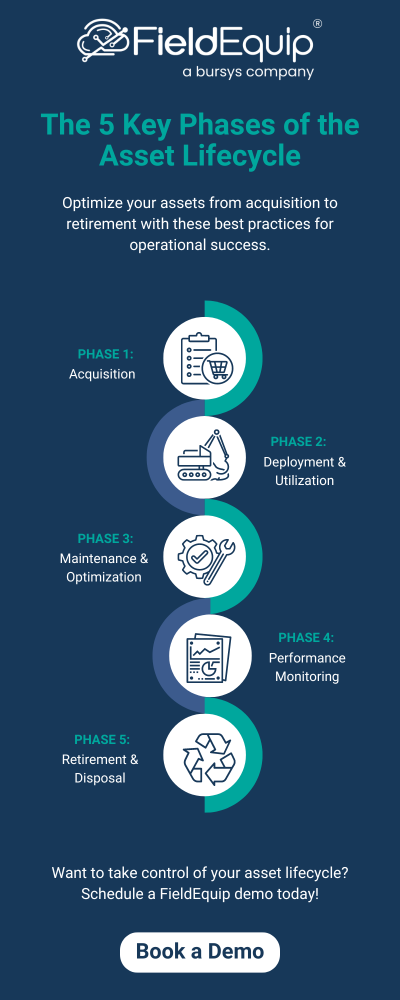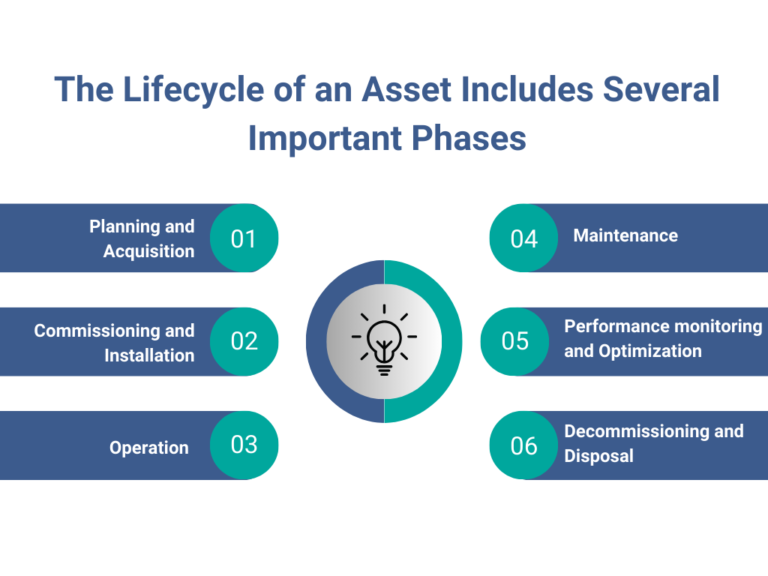Each stage of the asset lifecycle presents unique challenges and opportunities. When managed effectively, it can significantly impact the performance, cost-effectiveness, and overall value of assets.
Understanding the asset lifecycle is critical for effective industrial asset management. It enables organizations to optimize the value and performance of their assets throughout their entire operational lifespan.
Let’s explore the different stages of the asset lifecycle and the best practices for managing it.
The asset lifecycle is the comprehensive process through which companies acquire, store, utilize, and maintain their assets.
In industrial operations, understanding and managing the asset lifecycle is essential for optimizing asset performance, managing costs, and ensuring operational efficiency.

The acquisition phase of the asset lifecycle sets the stage for the entire lifespan of an asset.
Each stage ensures that the asset meets organizational needs and provides optimal value. Here’s a detailed look at each aspect of the acquisition phase.
Select and acquire assets that align with operational needs and meet industry standards, regulatory requirements, and safety guidelines. This will ensure efficiency, performance, and cost-effectiveness. Here are some best practices to guide you through this process:
Deploying assets into operation is a critical phase in the asset lifecycle. This phase sets the stage for the asset’s performance and integration into the operational environment.
It involves several key steps to ensure that your organization utilizes assets effectively:
Maintenance management is essential for prolonging asset life and ensuring optimal performance.
By implementing regular and proactive maintenance practices, organizations can:
Extend the operational lifespan of their assets,
Enhance reliability and efficiency, reduce operational costs, and ensure safety and compliance.
Effective maintenance management also supports strategic asset management, providing data and insights that contribute to informed decision-making and overall operational success
Predictive maintenance uses data and analytics to predict when you should perform maintenance according to the actual condition of the asset. This approach aims to address issues just before they lead to failure.
Organizations implement preventive maintenance implemented early in the asset lifecycle to ensure that assets operate efficiently.
However, predictive maintenance becomes particularly valuable in the middle and later stages of the asset lifecycle. It uses real-time data to optimize maintenance activities.
It is essential to optimize maintenance strategies by providing precise insights into the asset condition. This can enable more effective resource allocation and reduce unnecessary maintenance activities.
Predictive maintenance reduces maintenance costs by avoiding unnecessary maintenance tasks and focusing on interventions only when they are necessary.

Asset tracking provides real-time visibility into the conditions and locations of assets.
This capability is crucial for optimizing operations, ensuring efficient use of resources, and maintaining effective asset management practices.
The Internet of Things (IoT) and asset management software significantly enhance monitoring capabilities by providing actionable insights through real-time data collection, analysis, and visualization. Here’s how:
The final phase of the asset lifecycle—retirement or disposal—involves removing an asset from active service and managing its end-of-life processes.
This phase ensures that asset disposal maximizes value recovery, minimizes environmental impact, and adheres to regulatory requirements.
Here are the best practices to determine when to dispose of assets.
Managing the asset lifecycle effectively is crucial for optimizing asset performance, extending asset lifespan, and controlling costs.
Here’s how to maximize the benefits you experience across each phase of the asset lifecycle:
Regular inspections allow for the early detection of potential problems, such as wear and tear, corrosion, or minor malfunctions. So you can address them before they escalate into major failures.
Utilizing top-rated asset management software helps businesses to centralize all asset-related information in one place. Decision-makers can also monitor the performance of every asset to make informed decisions.
Leveraging equipment reports, companies can create detailed maintenance management plans to ensure timely servicing and troubleshooting to ensure maximum uptime and optimal efficiency.
Predictive maintenance programs help companies prolong assets’ life while ensuring minimum downtime and operational disruptions. Timely detection of potential issues saves time and excessive repair costs in case of major breakdowns.
Asset management software provides tools and functionalities that streamline, optimize, and enhance the management of assets from acquisition to disposal.
Here’s how asset management software supports each phase:

Asset management solutions help identify and document asset requirements based on operational needs and future projections. The software can track and compare vendor options, manage purchase orders, and streamline procurement processes.
It also assists in budgeting for asset acquisition by providing insights into costs, financial projections, and funding requirements.
Asset management software helps manage the commissioning and installation process. This includes scheduling, task assignments, and progress tracking to ensure timely completion.
It records and integrates asset data into the system, such as installation details, configuration settings, and operational parameters. This results in accurate and up-to-date information.
Asset management software provides real-time monitoring of asset performance and helps in tracking operational metrics to ensure assets function optimally.
It records and manages operational data, including usage patterns, performance metrics, and any anomalies, allowing for efficient operation and timely interventions.
The software automates maintenance reminders, manages work orders, and ensures that you perform maintenance tasks on time.
It maintains detailed records of all maintenance activities, repairs, and parts replacements. This is crucial for assessing asset performance, planning future maintenance, and ensuring compliance with maintenance protocols.
Asset management software provides advanced analytics and reporting capabilities to assess asset performance, efficiency, and utilization.
The software tracks key performance indicators (KPIs) and benchmarks, allowing for continuous assessment and improvement of asset performance
Asset management software assists in planning and managing the decommissioning process, including coordinating the removal, disposal, or sale of assets.
It maintains records of the asset’s lifecycle, including disposal documentation, ensuring compliance, and providing an audit trail for future reference.
Effective asset management is integral to maximizing the value and performance of your organization’s resources.
Adopting a strategic approach to asset management allows you to optimize performance, extend asset longevity, and make informed decisions that drive long-term success.
Now is the time to take charge of your asset management strategy. Review your current asset lifecycle processes, identify areas for improvement, and start implementing best practices to enhance your asset management.
Schedule a FieldEquip demo today to take the first step toward achieving operational excellence.
Would you like to have a free demo or have any questions about FieldEquip?
US Corporate Headquarters 1011 S. Hwy. 6, Suite 117 Houston Texas 77077 US